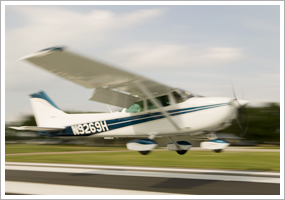| The following stories from the March 26, 2010, edition of AOPA ePilot were provided to AOPA members who expressed an interest in the particular subject areas. Any AOPA member can receive information tailored to their areas of interest by updating their preferences online. TRAINING TIPsWarm air, carb ice
Think of it as the ice of summer, but whatever you do, don’t ignore carburetor icing as a warm-weather flying hazard. Every year, carb ice foils some unwary pilots, even when temperatures soar toward 100 degrees Fahrenheit! The problem, explains Chapter 6 of the Pilot’s Handbook of Aeronautical Knowledge (6-7), is “the effect of fuel vaporization and the decrease in air pressure in the venturi, which causes a sharp temperature drop in the carburetor. If water vapor in the air condenses when the carburetor temperature is at or below freezing, ice may form on internal surfaces of the carburetor, including the throttle valve.” Scrutinize the chart accompanying the chapter; it depicts temperature-humidity combinations that pose the highest carb icing risks.
“Obviously, awareness of carb icing is especially important in the training environment, in which much time is spent practicing low-throttle exercises such as flight at minimum controllable airspeed, landing approaches, and simulated engine failure emergencies,” noted the Aug. 22, 2002, Training Tip that also discussed proper technique for applying carb heat.
Pilots must also understand a drawback of carb heat use: It robs the engine of power. So remove carb heat fully and promptly when adding throttle, for instance when commencing a go-around. How much power does carb heat sap from the engine? Next time you operate the carb heat during an engine run-up, or when reducing power to begin a practice maneuver, note the specific rpm drop. It can be considerable.
What else can you do in flight to improve your carb-ice risk awareness? Apply carb heat on occasion during cruise flight. Note if your power setting is higher after you remove it.
Another tip: “Develop the habit of keeping an eye on the outside air temperature along with rpm or manifold pressure gauges, while tuning the ear to engine smoothness,” wrote Dan Namowitz in the October 2009 Flight Training “Accident Analysis” column. Every detail matters because “carb heat may not save the day if added too late or too low.” TRAINING PRODUCTSA logbook fit for a flight instructorThe sturdy Flight Instructor’s Logbook from CFI Solutions has pages to keep track of endorsements, compliance with TSA citizenship validation rules, and certificate renewal and recurrent training. Working on Gold Seal designation? There’s a space to record that, too. The logbook is available from CFI Solutions for $26.95.
Note: Products listed have not been evaluated by ePilot editors unless otherwise noted. AOPA assumes no responsibility for products or services listed or for claims or actions by manufacturers or vendors. FINAL EXAMQuestion: I’m nearing the end of training for my private pilot certificate. Can you tell me what to expect on the checkride?
Answer: The FAA details the requirements of the various practical tests in what are called the practical test standards (PTS). The PTS for each certificate and rating is designed as the standard used by FAA inspectors and designated pilot examiners when conducting practical tests. Flight instructors are also expected to use these standards when preparing applicants for the practical tests. Having the requirements in writing leaves no doubt as to the standards an applicant must meet in order to pass a checkride. The practical test standards are periodically revised, so be sure to use the most current version for the certificate or rating for which you are training. For more information check out Reading the PTS . You also can download the most current version of the standards from the FAA.
Got a question for our technical services staff? E-mail [email protected] or call the Pilot Information Center, 800/872-2672. Don’t forget the online archive of “Final Exam” questions and answers, searchable by keyword or topic. CORRECTION: In the March 19 edition of AOPA ePilot Flight Training, we incorrectly identified the area of one type of thunderstorm for which a convective sigmet is issued. Convective sigmets may be issued for thunderstorms producing heavy or greater precipitation affecting 40 percent or more of an area at least 3,000 square miles. The area is incorrectly stated in the “Pilot’s Handbook of Aeronautical Knowledge”; the correct area can be found in the Aeronautical Information Manual ( AIM 7-1-6 (d)). |
 As the snows of winter vanish from airport landscapes, pilots cheer the disappearance of snowdrift hazards, icy patches on runways, and morning frost on aircraft. But another ice hazard becomes more likely when temperatures climb.
As the snows of winter vanish from airport landscapes, pilots cheer the disappearance of snowdrift hazards, icy patches on runways, and morning frost on aircraft. But another ice hazard becomes more likely when temperatures climb.